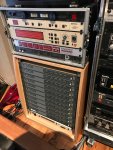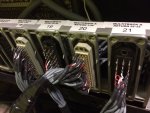Oh I totally understand the spontaneity of other, non-DAW approaches...though, with use of templates and a predetermined workflow, it is possible to have some of that with a DAW also...but yeah, when I have my tape deck spooled up...it's just two buttons, and I'm recording.

That said...there still is a session preparation process even with tape or ADAT or whatever...that makes the spontaneity truly spontaneous. You have to spool the tape, patch the patchbay, set up your mics and whatever...etc.
I don't use it anymore (not sure why)...but my grab-n-go "ideas" recorder was always a cassette deck. It was quick to load up, and as long as I had a mic patched, I could grab a guitar and knock out some licks or tryout an arrangement, and be able to as quickly hear it back.
With a DAW there is certainly the most "prep" than any other medium that I've seen...unless you wanna do real sloppy-on-the-fly stuff. Just naming the files takes up time. With the tape deck, I can write down with pencil and paper much easier/faster.
Anyway...my question about the ADAT was more about the "for keeps" kind of tracking...where you would want everything to be on the same quality level.
My approach would be to pick out what I considered the "best" of the 3 formats you have on hand, and work out the sessions in chunks to make do with the limited track counts...and then just dump to the DAW and rewind, and add more. I mean, that's what the point of the sync is anyway...to allow that.
Of course, if you feel that locking up the MSR-16, the 5050 MKIII and the ADATs...and recording simultaneously to them will give you what you want, then that's your rig.
Only reason I even asked is that it reminded me of something I was doing way back...when I had a sequencer, a tape deck, etc., and I kinda become focused on making all the gear work together, getting it all sync-locked, and being able to go in any direction, or making any one the master or slave...etc...etc...
...and while I was able to technically have this involved, multi-piece synchronized rig, I quickly came to the conclusion that I was going overboard, and realistically, there was no real need for it on any regular basis....considering that I was never going to record more than a handful or two of tracks at the same time.
IOW, my whole workflow by its nature, broke things down to the drums and the rhythm tracks...then some additional, filler instruments...then the leads and vocals...etc. Even with a 4-5 piece band, it was often the same process...though maybe more mics.
Now, if you're talking really large sessions, with many players...then you can't get around it, you need the extra tracks.
So thinking back to my own situation...I realized that I was doing the elaborate sync hook-up just because I wanted to and to see if I could...not so much that I needed it or that I should. It reminded me of this movie clip...

So FFW...
These days I just go with my 2" 24-track...and I sold off my couple of 1/2" 16-track decks. When I need more tracks...I sync the 24-track deck to the DAW, dump some tracks off the tape, and add new ones...though I rarely do that any more. Instead, I find that I'll use the initial 24 tracks (well, 23 actually) off the tape, and then if I need to add a couple new tracks, I'm now going direct to DAW most times....unless I had like a couple of takes on the tape, and I wanted to do another one or two takes, then I'll go back to the tape, just so all the takes have the same overall sound.
Anyway...post back when you get all your pieces and cables together and working as you want.





 In the end I went with the spare that I had, set up an ebay search job and bought a few more of these units whenever they popped up in Germany for a reasonable price. They have different ROM versions and different add-on card configurations but I think it's safe to say that I won't run out of devices anytime soon. It's a different story though with the PSUs where I only have one spare. I think I'd go Cory's route of using an ATX PSU unless you have something up your sleeve that needs less modification? Here's a picture of the Micro Lynx rack:
In the end I went with the spare that I had, set up an ebay search job and bought a few more of these units whenever they popped up in Germany for a reasonable price. They have different ROM versions and different add-on card configurations but I think it's safe to say that I won't run out of devices anytime soon. It's a different story though with the PSUs where I only have one spare. I think I'd go Cory's route of using an ATX PSU unless you have something up your sleeve that needs less modification? Here's a picture of the Micro Lynx rack:

 ), the tape decks...I have no idea how this stuff will go one day, though I'm sure some of it will sell easy enough, but there's a LOT of stuff that's accumulated over the years, and I hate to say it, like some of the amps, it's not getting used as much anymore. I've developed my favorites and my workflow...so I kinda stay with that.
), the tape decks...I have no idea how this stuff will go one day, though I'm sure some of it will sell easy enough, but there's a LOT of stuff that's accumulated over the years, and I hate to say it, like some of the amps, it's not getting used as much anymore. I've developed my favorites and my workflow...so I kinda stay with that. I went through the same with amps and kept lowering the price again and again. Sometimes you just have to wait (I use another classifieds service here, not ebay). I pick the buyers then, all local. It's ok for me if it goes to someone nice for a lower price. The stuff I want to let go goes down in price anyway and the stuff I want to keep, keeps going up
I went through the same with amps and kept lowering the price again and again. Sometimes you just have to wait (I use another classifieds service here, not ebay). I pick the buyers then, all local. It's ok for me if it goes to someone nice for a lower price. The stuff I want to let go goes down in price anyway and the stuff I want to keep, keeps going up 